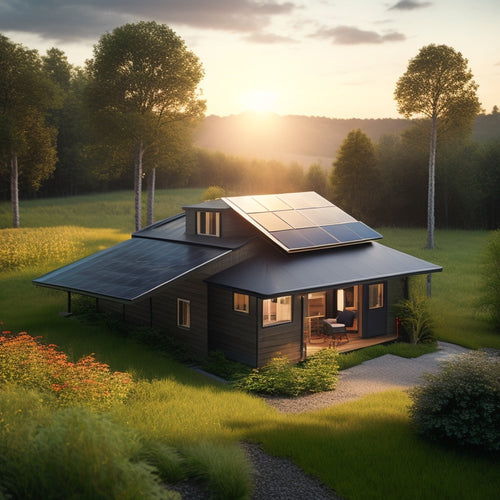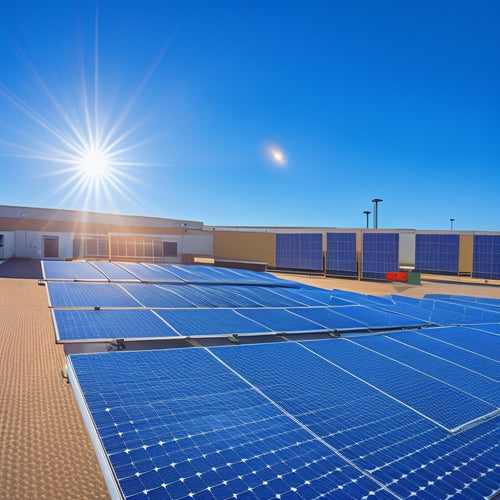
Solar Panels for Home Use Cost
Share
You're considering investing in solar panels for your home, and you're wondering about the cost. The good news is that solar panels can lead to substantial cost benefits over time, with energy savings reaching up to 50% based on your consumption. High-efficiency solar panels with advanced inverter technology can enhance energy harvesting capabilities, reducing your reliance on the grid. To maximize energy production, it's essential to assess your roof's shading patterns, ensuring ideal panel placement. By understanding these factors, you can make an informed decision about investing in solar panels for your home, and uncover how much you can expect to save in the long run.
The Essentials
- The cost of solar panels for home use varies depending on the system size, quality, and installation company, with average prices ranging from $15,000 to $30,000.
- Homeowners can save up to 50% on their electricity bills by generating clean energy through solar panels, leading to long-term cost benefits.
- Federal and state tax credits, as well as rebates, can significantly reduce the upfront cost of solar panels, making them a more affordable option.
- High-efficiency solar panels can lead to substantial cost benefits over time, as they generate more power per hour of sunlight than lower-efficiency panels.
- The cost of solar panels can be offset by increased home value, with some studies suggesting a 4-6% increase in property value after installation.
Capture Free Renewable Energy
You can utilize a natural energy source by installing solar panels on your home, reducing your reliance on fossil fuels and lowering your carbon footprint.
By capturing free renewable energy from the sun, you'll not only reduce your energy costs but also contribute to a cleaner environment.
As concern for the environment and energy efficiency continues to grow, many homeowners are turning to renewable power solutions as an alternative to traditional energy sources.
With solar panels, you'll generate clean energy and decrease your impact on the planet.
Harness Natural Energy Source
As we move towards a more sustainable future, utilizing natural energy sources becomes an appealing option for homeowners. You're likely considering utilizing solar energy to power your home, and for good reason.
Solar technology has advanced greatly, making it a viable renewable solution for reducing your reliance on fossil fuels. By embracing Renewable Energy Solutions, you can tackle three major concerns at once: reducing your electricity bills, providing backup power during outages, and minimizing your carbon footprint.
By tapping into natural resources like sunlight, you're not only reducing your environmental impact but also taking a step towards energy independence. This means you'll be less affected by fluctuating energy prices and have more control over your energy consumption.
With solar panels, you can generate clean energy and feed any excess back into the grid, offsetting your energy costs.
As you investigate solar energy options, consider the long-term benefits of sustainable living. You'll be contributing to a cleaner environment, reducing greenhouse gas emissions, and supporting the energy shift.
Reduce Carbon Footprint Now
Reduce Carbon Footprint Now
Solar panels enable homeowners to capture free renewable energy, considerably reducing their carbon footprint. By switching to solar power, you can greatly decrease your reliance on fossil fuels and lower your emissions. This not only benefits the environment but also contributes to a sustainable lifestyle.
Here's a breakdown of how solar panels can help reduce your carbon footprint:
| Carbon Offset Strategies | Sustainable Lifestyle Choices | Benefits |
|---|---|---|
| Reduce energy consumption | Use energy-efficient appliances | Lower energy bills |
| Invest in renewable energy | Install solar panels | Reduce carbon emissions |
| Conserve water | Install low-flow showerheads | Preserve natural resources |
| Use public transport | Carpool or use electric vehicles | Reduce air pollution |
| Recycle waste | Implement recycling programs | Conserve natural resources |
Lower Your Electricity Bills
You're likely looking for ways to lower your electricity bills, and installing solar panels can help you achieve that.
By utilizing renewable energy, you'll not only reduce your energy expenses but also contribute to a more eco-friendly environment.
With solar power, you can considerably cut your power consumption, leading to lower electricity bills and a reduced carbon footprint.
Reduce Energy Expenses
Your electricity bills have been steadily increasing, and it's time to take control of your energy expenses. By installing solar panels, you can greatly reduce your energy expenses, enjoying substantial cost benefits in the long run.
With solar power, you'll generate your own clean energy, relying less on the grid and lowering your electricity bills. This translates to energy savings of up to 50% or more, depending on your energy consumption and the size of your solar panel system.
Reducing your energy expenses means you'll have more money in your pocket for the things that matter. You'll enjoy financial freedom, no longer held back by rising energy costs.
Plus, with solar panels, you'll increase your home's value and appeal, making it more attractive to potential buyers if you decide to sell in the future.
Cut Power Consumption
Efficiency takes center stage when it comes to cutting power consumption. You can't just install solar panels and expect your energy bills to plummet. You need to optimize your home's energy usage to reap the benefits of renewable energy.
| Energy-Saving Tip | Benefits |
|---|---|
| Replace traditional bulbs with LEDs | Up to 80% energy savings |
| Invest in energy efficient appliances | Up to 30% energy savings |
| Implement smart home technology | Real-time energy monitoring and automation |
Efficient Inverter Technology Explained
When you're evaluating solar panel systems, you'll come across inverter efficiency ratings, which notably impact your energy output.
You'll want to understand how these ratings are calculated and what they mean for your system's performance. A high-performance battery, such as a lithium ion battery for solar system, can also play an essential role in maximizing your energy storage.
Additionally, you'll benefit from learning about power optimization systems that can further maximize your energy harvest.
Inverter Efficiency Ratings
Most solar panel systems rely on inverters to convert DC power into AC power, making it usable in homes. When selecting an inverter, you should consider its efficiency rating, which affects the overall performance of your solar panel system. Inverter efficiency ratings vary depending on the type of inverter and its quality.
Here is a comparison of different inverter types and their typical efficiency ratings:
| Inverter Type | Typical Efficiency Rating | Inverter Lifespan |
|---|---|---|
| String Inverter | 95-98% | 10-15 years |
| Microinverter | 90-95% | 20-25 years |
| Power Optimizer | 95-98% | 20-25 years |
| Central Inverter | 95-98% | 10-15 years |
| Hybrid Inverter | 90-95% | 10-15 years |
When choosing an inverter, look for high-efficiency ratings and a long lifespan to guarantee maximum energy production and minimal maintenance. Keep in mind that higher-efficiency inverters may come at a higher cost.
Power Optimization Systems
Your solar panel system's ability to generate maximum energy relies heavily on the performance of its inverter.
That's why power optimization systems play an essential role in ensuring you get the most out of your solar panels. These systems use advanced power management techniques to monitor and control the energy output of each panel, maximizing energy production and reducing losses.
By integrating power optimization systems into your solar panel setup, you can expect increased energy yields, improved system reliability, and enhanced monitoring capabilities.
This is achieved through advanced system integration, which enables real-time monitoring and control of individual panels, allowing for swift detection and resolution of any performance issues.
With power optimization systems, you can optimize energy production, reduce energy waste, and enjoy a more efficient and reliable solar panel system.
Check Your Roof's Shading
When evaluating your roof's suitability for solar panels, you'll need to identify obstacles that cast shade, such as chimneys, vents, and skylights.
It's crucial to contemplate the impact of shading on your energy production, as it can considerably reduce the efficiency of your renewable energy systems.
You should also think about the changing shading patterns throughout the day and year, considering the movement of trees, buildings, and other obstructions.
Roof Obstacles to Consider
Beyond the roof's size and orientation, homeowners must account for obstacles that cast shade on their roof, as even partial shading can considerably impact solar panel performance.
You'll want to assess your roof's material, as certain types like asphalt shingles or metal can affect the installation angles of your solar panels. Trees, chimneys, vents, and skylights are common obstacles that can block sunlight and reduce energy output.
Consider the height and proximity of these features to your roof, as well as the time of day and year when shading is most likely to occur.
When evaluating your roof's obstacles, think about the installation angles of your solar panels. A south-facing roof with a pitch between 30 and 40 degrees is ideal, but adjustments can be made to accommodate varying roof angles.
You may need to install panels at different heights or angles to minimize shading. A thorough assessment of your roof's obstacles will help you determine the best configuration for your solar panel system, ensuring maximum energy production and a reliable return on investment.
Shading Patterns Over Time
Shading patterns on your roof change throughout the day and year, impacting your solar panel system's performance. As the sun moves across the sky, different parts of your roof receive varying amounts of shade, affecting the amount of energy your solar panels can produce. You'll want to take into account these shading patterns when determining the ideal location and configuration of your solar panel system.
| Time of Day | Seasonal Variations | Shading Effects |
|---|---|---|
| Morning | Winter | Trees and buildings cast longer shadows |
| Afternoon | Summer | Shading from trees and buildings is minimized |
| Late Afternoon | Spring/Fall | Shading from trees is moderate |
To maximize energy production, you'll want to minimize shading effects by positioning your solar panels in an area that receives the most direct sunlight throughout the day. Take note of any obstacles, such as trees or buildings, that may cast shadows on your roof and adjust your system's design accordingly. By understanding and accounting for shading patterns, you can optimize your solar panel system's performance and enjoy maximum energy independence.
Higher Energy Conversion Rate
When you invest in solar panels for home use, you want to guarantee you're getting the most out of your system.
That's where efficient energy harvesting systems come in, as they considerably enhance your higher energy conversion rate.
Efficient Energy Harvesting Systems
By opting for high-efficiency solar panels, you can maximize your energy harvesting capabilities, thereby minimizing your reliance on the grid. This means you'll be producing more power per hour of sunlight, reducing your energy bills, and taking a significant step towards energy independence.
High-efficiency solar panels incorporate advanced solar technology, featuring higher power output ratings and improved temperature coefficients. These state-of-the-art systems enable you to generate more electricity from the same amount of sunlight, ensuring you get the most out of your investment.
With efficient energy harvesting systems, you'll be able to power more appliances, lights, and devices while reducing your carbon footprint.
When shopping for solar panels, look for high-efficiency models with high power output ratings (measured in watts) and low temperature coefficients (measured in percentage per degree Celsius). By doing so, you'll be well on your way to achieving energy independence and reaping the benefits of reliable, clean, and sustainable energy.
Frequently Asked Questions
Can I Install Solar Panels Myself to Save Money?
You can attempt a DIY installation to reap cost savings, but it's essential to evaluate your technical knowledge, local building codes, and warranty implications before taking on the project to guarantee a safe and efficient solar panel installation.
Do Solar Panels Work During Power Outages?
You might think solar panels are useless during power outages, but that's not entirely true; with backup systems, you can achieve energy independence, ensuring you still have power when the grid goes down.
How Long Does It Take to Install Solar Panels?
You'll typically spend 1-3 days overseeing the installation process, but the entire installation timeline, from permit to power-on, can take 2-6 months, depending on local regulations and the complexity of your solar panel system's design.
Can I Sell Excess Energy Back to the Grid?
You'll enjoy parallel benefits: generating clean energy and offsetting your consumption. Through net metering benefits and energy buyback programs, you'll sell excess energy back to the grid, reducing your bill and increasing your energy independence.
Are Solar Panels Resistant to Hail and Extreme Weather?
You'll be relieved to know that most solar panels are designed to withstand extreme weather conditions, including hail damage, with tempered glass and durable frames that can resist impacts and harsh environmental elements.
Final Thoughts
Considering a switch to solar panels for home use? You've made a smart decision. Not only will you capture free renewable energy, but you'll also lower your electricity bills. With efficient inverter technology, you'll maximize energy conversion. Before installation, check your roof's shading to guarantee peak performance. Did you know that, according to the US Department of Energy, a typical American family can save up to $400 annually on their electricity bills by going solar? Make the switch and start utilizing the power of the sun!
Related Posts
-

Diy Off Grid Solar
By embracing DIY off-grid solar, you can break free from grid dependence, slashing your energy bills by up to 90% and...
-

Essential Solar Panel Mounts for Commercial Properties
When it comes to essential solar panel mounts for your commercial property, durability and wind resistance are key fa...
-

Top Solar Powered Camping Fans for Camping Enthusiasts
If you're a camping enthusiast, a solar-powered fan can be a transformative element for your outdoor experience. Thes...


